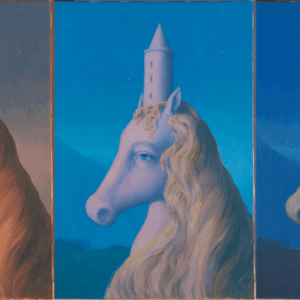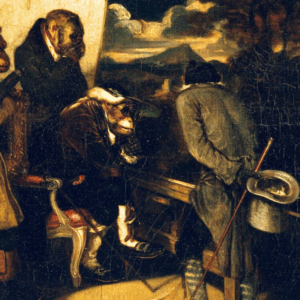
“Never Had a Dirty Book Done So Badly.” On Some Unlikely Books First Published with Viking
Paul Slovak Digs Into Titles by Leonard Cohen, John Williams, Alfred Doblin, and More
The Viking Press was founded in 1925 and will be celebrating its one hundredth anniversary this fall. I began working there in 1983 as a publicity assistant, and after helming the Viking publicity department in the first half of the 1990s, I became an editor for the imprint, where I worked with everyone from T.C. Boyle, Rebecca Solnit, and William T. Vollmann to Geraldine Brooks, Sue Monk Kidd, and Amor Towles.
Over the years—I worked there till the fall of 2023—I became a sort of unofficial historian of Viking, the one who knew something about who the founders and the legendary editors were. There were others before me, including Elisabeth Sifton and Gerald Howard. Here are six books, from the first fifty years of its existence, that you may not be aware Viking originally published in hardcover.
*
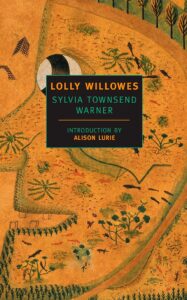
Sylvia Townsend Warner, Lolly Willowes (1926)
When the Book‑of‑the‑Month Club was launched in 1926, the very first main selection of its judges was a Viking book—Lolly Willowes, a debut work of fiction by the British novelist, short story writer, and poet Sylvia Townsend Warner (1893–1978). The pitch for this novel sounds as if it would play well today—a comedy of manners incorporating elements of fantasy, about a middle‑aged spinster who moves to a country village to escape her controlling relatives and takes up the practice of witchcraft. It became an international bestseller, and Viking went on to publish all of Warner’s work, including seven novels and several collections of short stories and poetry. Lolly Willowes went out of print and was eventually republished in paperback in 1999 by New York Review Books, with an introduction by Alison Lurie, who called it a “revolutionary” novel that “spoke to single women of all ages.” The novel is now in the public domain and several other paperback editions are available.

Alfred Doblin, Alexanderplatz, Berlin (1931)
During its early years Viking was heavily invested in publishing European fiction in translation, most of which was acquired by the legendary editor B.W. Huebsch, who worked with Franz Werfel, Lion Feuchtwanger, and Stefan and Arnold Zweig, among many others. In 1931, six years after its founding, the firm issued, in a two‑volume boxed set, the German writer Alfred Döblin’s novel Alexanderplatz, Berlin, translated by Eugene Jolas, a friend of James Joyce’s. This monumental work, which was acclaimed for its innovative use of literary montage and which Viking billed in its catalog copy as “the German Ulysses” and “an event of the greatest importance in literary history,” told the story of an ex‑convict who has just been released from prison for killing his lover.
“The man isn’t of any consequence (there are millions like Franz Biberkopf),” said Viking in its copy, “but the tale of his world, as revealed in one adventure after another, is of consequence to us all.” The Frederick Ungar Publishing Company released the paperback edition I own, under a reprint license from Viking, and New York Review Books published a new translation by Michael Hofman in 2018. The novel won renewed interest in 1980 when Rainer Werner Fassbinder turned it into a fourteen‑part film for German television.
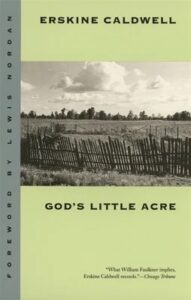
Erskine Caldwell, God’s Little Acre (1933)
Controversy erupted in 1933 over Viking’s publication of Erskine Caldwell’s fourth novel, God’s Little Acre, a story of farmers in Georgia digging futilely for gold. In its catalog copy Viking admitted that while “as in other Southern novels that have recently roused attention, the sex theme is important,” the book was “comic in a deep and laughable way” and “rises to a climax of real emotion which transcends any puritanical considerations.” The Saturday Review of Literature called it “one of the finest studies of the southern poor white which has ever come into our literature.”
But the novel’s sexual themes were so controversial that the New York Society for the Suppression of Vice asked a state court to censor it. This was Viking’s first appearance in a court case, and co-founder Harold Guinzburg himself testified for the defense. Many literary figures of the time supported the book, and the court ruled in favor of Caldwell, a decision that Publishers Weekly called “a milepost in the fight against censorship.” The novel went on to become an international bestseller with more than 14 million copies sold, but that didn’t stop the threat of censorship; the city of St. Paul banned the novel in 1947 for being pornographic, and the novel was banned in Boston in 1950. It is in print today from the University of Georgia Press.
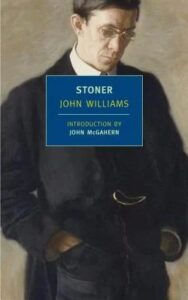
John Williams, Stoner (1965)
In 1965 Viking published, to little notice or acclaim or sales, the novel Stoner by John Williams, a downbeat story of a quiet English professor in Missouri who encounters a succession of disappointments in his life and career. Corlies “Cork” Smith, Williams’s editor at Viking, would later say that Stoner was the hardest book he ever had to present at a sales conference—and Cork was a master at that particular skill. Viking also published Williams’s subsequent novel, Augustus (1972), which explored the life of the founder of the Roman Empire and was a co-winner of the National Book Award. Both books sold modestly, and eventually Viking let the rights revert. In 2006, Stoner was reissued to widespread acclaim by New York Review Books, with an introduction by John McGahern; it became recognized, more than forty years after its first publication, as an American classic, and current sales of the 2006 paperback edition in all formats are at 375,000 copies.

Leonard Cohen, Beautiful Losers (1966)
In the fall of 1963, Viking published a first novel by a young Canadian, Leonard Cohen, who also wrote verse and would in a couple of years emerge as a renowned songwriter. President and Publisher Tom Guinzburg, son of Viking co-founder Harold Guinzburg, bought the U.S. rights to the book on a trip to London, and Cork Smith edited it. Titled The Favorite Game, the novel etched the early life of the only son of well‑to‑do Jewish parents in Montreal. Viking then published a collection of poetry with Cohen, The Spice-Box of Earth (1965). As for Cohen’s next novel, Beautiful Losers, which was set in an apartment in Montreal as a bereaved and lust‑tormented narrator reconstructs his relations with the dead, there was a sharp divide of opinion internally at Viking.
The catalog copy noted that it “became the source of a remarkable amount of animated discussion and debate.” The younger editors (Catharine Carver and Aaron Asher) were for it, but Viking General Manager Marshall Best, who had been with the company since 1925, was strongly against it, finding the novel offensive and calling it “gilded shit.” In the end, Guinzburg let Smith buy the novel for $3,000. Smith later recalled that “we sold maybe 2,500 copies. I remember Aaron Asher said of Beautiful Losers, ‘Never had a dirty book done so badly.’” Viking was able to sell the mass‑market paperback rights on the book to Bantam, whose cover copy advertised it as “the complete unexpurgated edition” from “the most daring novelist on the scene today!” It sold hundreds of thousands of copies for Bantam. Today, Vintage publishes the trade paperback edition.

Frederick Forsyth, The Day of the Jackal (1971)
While Viking often fashioned itself as an extremely literary publisher, the truth was that it was always interested in fiction of a more commercial bent as well. In his oral history Tom Guinzburg commented that his father Harold “loved thrillers. I mean, he would rather have had a thriller writer almost more than the most elegant literary person any of us could name.” Harold was instrumental in bringing Ian Fleming to the Viking list in the early 1960s, and personally edited the mystery author Rex Stout for Viking. Some ten years later, in 1971, Viking published The Day of the Jackal, the debut novel by the British author Frederick Forsyth.
Viking editor Alan Williams acquired the book; he would often recall that he was so engrossed by his first reading of the novel that he missed his commuter stop in Princeton and rode his train all the way to the end of the line. Williams made the crucial suggestion to Forsyth that he should jettison the backgrounding first chapter and begin the novel instead with the assassin. The book was immensely popular, and Viking published five additional novels with Forsyth, including The Odessa File (1972) and The Dogs of War (1974), all of them massive bestsellers, though by the end Viking was paying such high advances for them that it began to affect the company’s bottom line. The book is currently in print in paperback from Putnam.
Paul Slovak
Paul Slovak joined Viking Penguin in 1983 and was Viking’s publicity director before transitioning to editorial twenty-five years ago. Slovak edits a wide range of fiction and nonfiction, including memoir, cultural history, science, and natural history. Novelists he has worked with include T.C. Boyle, Geraldine Brooks, Susan Choi, Roddy Doyle, Sue Monk Kidd, William Kennedy, Ruth Ozeki, Amor Towles, and William T. Vollmann. In nonfiction, Slovak has edited memoirs by Elizabeth Gilbert, David Byrne, and Leslie Marmon Silko, and works of natural and cultural history by Robert Macfarlane, David George Haskell, and Rebecca Solnit. Slovak also edits six works of poetry every year under the Penguin Poets imprint. His poets include Joshua Bennett, Heid E. Erdrich, Amy Gerstler, Terrance Hayes, Ann Lauterbach, J. Michael Martinez, Adrian Matejka, Alice Notley, Willie Perdomo, sam sax, Paul Tran, Anne Waldman, and Phillip B. Williams.
















